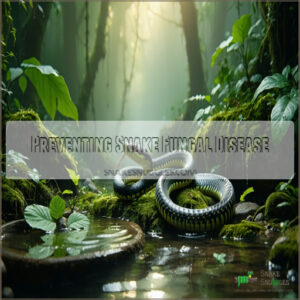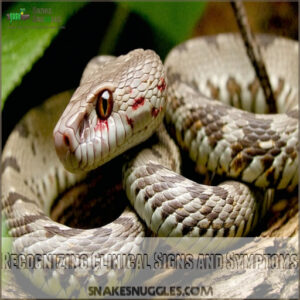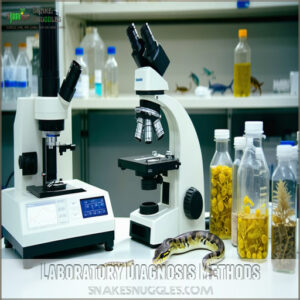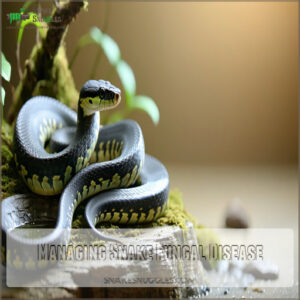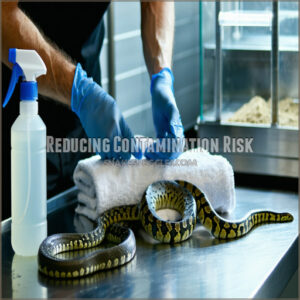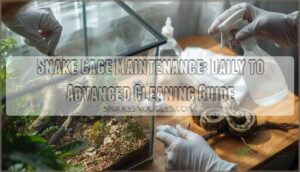This site is supported by our readers. We may earn a commission, at no cost to you, if you purchase through links.

Start by keeping your snake’s environment clean – sterilize soil regularly and disinfect all equipment after use.
Watch for warning signs like swollen faces, crusty skin, or unusual nodules.
Make habitat modifications to reduce dense vegetation where fungal spores thrive.
Regular monitoring helps catch issues early, while proper cleaning routines keep pathogens at bay.
Think of it as giving your slithery friend a clean, healthy home.
Understanding the impact of these diseases reveals surprising connections between environmental care and snake health, and how proper cleaning and regular monitoring can make a significant difference.
Table Of Contents
- Key Takeaways
- Preventing Snake Fungal Disease
- Identifying Snake Fungal Disease
- Managing Snake Fungal Disease
- Controlling Fungal Disease Spread
- Protecting Snake Populations
- Frequently Asked Questions (FAQs)
- How to prevent snake fungal disease?
- What can you do to prevent syphilis?
- How do you treat snake fungus?
- How do you manage snake disease?
- Can snake fungus be eradicated?
- Does antifungal treatment work for colubrid snakes?
- How can snake fungal disease be prevented?
- How can you prevent the spread of fungal diseases?
- How can you prevent a fungal infection?
- How do you control fungal diseases in animals?
- Conclusion
Key Takeaways
- You’ll prevent snake fungal diseases by regularly sterilizing soil, disinfecting equipment, and maintaining proper environmental hygiene in your snake’s habitat.
- You can spot early warning signs by watching for swollen faces, crusty skin, or unusual nodules – catching these symptoms early helps prevent disease progression.
- You’ll need to modify habitats by reducing dense vegetation where fungal spores thrive and implementing regular cleaning routines to keep pathogens at bay.
- You should combine antifungal treatments with proper thermal, fluid, and nutritional support when managing infected snakes, though complete recovery is rare and requires consistent monitoring.
Preventing Snake Fungal Disease
You can protect snakes from fungal diseases by keeping outdoor equipment clean, preventing soil contamination, and reducing their exposure to harmful environments.
Regularly monitoring snake populations also helps you catch issues early and support conservation efforts.
Maintaining Cleanliness of Outdoor Equipment
Keeping outdoor equipment clean is critical to prevent snake fungal disease.
Ophidiomyces, a snake fungal disease pathogen, spreads through contaminated soil.
Dirty boots or tools spread contaminated soil, risking environmental contamination and spreading ophidiomycosis.
- Wash outdoor gear with soap and water after each use.
- Sanitize equipment using a disinfectant to kill pathogens.
- Scrub boots and soles to remove dirt, ensuring thorough cleaning.
Preventing Soil Contamination
Dirty soil can harbor fungal spores, spreading snake fungal disease.
Regular soil sterilization helps reduce contamination risks, especially in and around snake habitats.
Disinfect tools and footwear after handling contaminated soil to prevent environmental contamination.
Practice consistent environmental cleaning and soil disinfection to maintain healthy enclosures.
Understanding fungal disease impacts is important for effective prevention strategies.
| Action | Tool/Method | Frequency | Purpose |
|---|---|---|---|
| Soil Sterilization | Heat or Chemicals | Annually | Reduce fungal spore load |
| Tool Cleaning | Disinfectants | After Use | Minimize spread |
| Footwear Cleaning | Scrubbing, Spray | After Outdoor Work | Prevent environmental risk |
| Habitat Hygiene | Clean Substrate | Every 2-3 Weeks | Maintain healthy enclosure |
Limiting Environmental Exposure
To prevent snake fungus, limit exposure to contaminated areas.
Modify habitats by reducing dense vegetation where fungal spores thrive.
Regular environmental cleaning and soil disinfection near snake habitats can lower risks.
Focus on snake habitat hygiene by keeping outdoor areas clean and discouraging wildlife interaction.
Small steps like these help control fungal spore spread and protect snakes, which is crucial for maintaining healthy ecosystems and preventing the spread of disease, thereby supporting overall wildlife interaction management.
Monitoring Snake Populations
You’ve minimized exposure risk, but tracking snake populations is just as important.
Wildlife monitoring helps you spot population trends and detect early signs of snake fungal disease. Regular disease surveillance in snake habitats supports species conservation and wildlife health.
By observing wildlife closely, you’re preventing ophidiomycosis and protecting snakes. Stay alert—small efforts can lead to big conservation impacts!
Identifying Snake Fungal Disease
You can identify snake fungal disease by watching for signs like swollen faces, crusty skin, and unusual nodules.
Accurate diagnosis often requires collecting samples for lab tests, like PCR or microscopic tissue analysis, to confirm the presence of snake fungal disease.
Recognizing Clinical Signs and Symptoms
For snake fungal disease, watch for facial lesions, nodal swelling, or discolored scales.
Skin ulcers and eye infections could appear as the infection worsens. Early signs include small skin lesions that spread, making the snake uncomfortable.
Check for difficulty moving, feeding, or respiratory issues. Recognizing these clinical signs early helps address fungal infection symptoms before they escalate.
Laboratory Diagnosis Methods
Spotting Snake Fungal Disease symptoms is step one, but confirming it takes science.
PCR testing detects fungal DNA, while fungal culture grows the culprit in a lab.
Histopathology examines tissues for fungal infection signs. Microscopy examination offers a closer look, though less precise.
Accurate diagnosis provides better care—always handle samples carefully to avoid damaging results, ensuring the best possible care.
Managing Snake Fungal Disease
You can manage snake fungal disease by combining antifungal treatments with proper care, like thermal, fluid, and nutritional support.
These steps help snakes recover while reducing the impact of the infection on their overall health, by providing complete concepts of care.
Antifungal Medication Treatment
Treating snake fungus with antifungal medications can be tricky, as full recovery is rare. Antifungal therapy often combines topical or systemic drugs with supportive care to improve outcomes.
Ophidiomycosis treatment is still evolving, with drug resistance posing challenges. Effective fungal disease management requires a thorough approach to prevent the spread of infection.
- Common treatments: Topical and systemic antifungals.
- Challenges: Limited medication efficacy.
- Supportive care: Nutritional and thermal support.
- Promising option: Terbinafine nebulization.
Thermal and Fluid Support
Maintaining proper thermal support and fluid therapy is essential for managing snake fungal diseases like ophidiomycosis.
Maintain consistent heat support to boost immunity and aid recovery. You can find suitable snake heat lamps online.
Hydration methods, like soaking or oral fluids, prevent dehydration.
Environmental control is key—monitor temperature and humidity closely.
| Care Aspect | Importance | Examples |
|---|---|---|
| Thermal Care | Boosts recovery | Heat lamps, warm mats |
| Fluid Therapy | Prevents dehydration | Oral fluids, soaking |
| Environmental Control | Reduces stress, aids recovery | Adjust temperature, humidity |
Nutritional Support and Care
After maintaining hydration, focus on proper feeding to boost snake health. Meeting dietary needs supports recovery and maintains strength.
Follow this snake care guide:
- Offer species-appropriate prey to meet diet and nutrition requirements.
- Maintain a healthy environment to reduce stress and aid digestion.
- Monitor feeding habits closely; changes may signal health issues.
Proper snake care involves using the right snake food supplements to ensure best health.
Good nutrition equals better reptile health, and it is essential for recovery.
Controlling Fungal Disease Spread
You can help control the spread of snake fungal disease by keeping environments clean and reducing contamination risks.
Simple actions, like cleaning equipment and avoiding soil transfer, play a big role in protecting snakes.
Preventing Transmission Through Environment
Stopping fungal disease starts with good habitat hygiene. Regular reptile enclosure cleaning, equipment sanitizing, and soil disinfection keep the environment safe.
Modify habitats to reduce fungal spread and prevent ophidiomycosis. Focus on fungal eradication by removing contaminated materials. Clean tools and boots before and after use to limit environmental spread.
Small actions protect snakes from fungal disease. The following tasks are crucial for preventing the spread of fungal diseases:
| Task | Frequency | Purpose |
|---|---|---|
| Enclosure Cleaning | Weekly | Removes fungal spores |
| Equipment Sanitizing | After each use | Stops contamination spread |
| Soil Disinfection | Monthly | Reduces fungal disease risk |
Reducing Contamination Risk
Keeping things clean is key to protecting snakes from fungal diseases.
Reduce contamination risks by:
- Clean Equipment: Wash tools and boots after visiting snake habitats.
- Soil Disinfection: Avoid spreading infected soil by disinfecting gear.
- Environmental Hygiene: Regularly clean reptile enclosures to stop fungus growth.
Proper hygiene and careful snake handling go a long way in preventing ophidiomycosis.
Implementing Preventative Measures
You’ve got to stay ahead in fungal disease prevention by focusing on clean equipment and soil sanitization.
Controlling the environment reduces snake fungal infection risks. Regular population monitoring and disease surveillance help catch issues early.
Preventing ophidiomycosis means limiting exposure to contaminated areas. Prioritize cleanliness and environmental control to protect snakes and support effective disease prevention efforts in their habitats.
Understanding the snake fungal disease is essential for developing successful prevention strategies.
Protecting Snake Populations
You’ll protect wild snake populations by monitoring their health and reporting any sick or dead snakes to local wildlife authorities.
You can help maintain snake biodiversity by keeping your outdoor equipment clean and preventing soil contamination that spreads fungal diseases.
You’ll also be contributing to the preservation of ecosystems by following these guidelines, which is crucial for maintaining snake biodiversity.
Conserving Threatened Species
The rise in snake fungal infections has put several species at risk, particularly the Timber Rattlesnake and Kirtland’s snake.
Wildlife conservation efforts now focus on habitat preservation to protect these vulnerable populations. You’ll find research teams working tirelessly to understand how reptile fungal disease affects different species.
By supporting conservation initiatives and following recommended guidelines, you’re helping maintain healthy snake populations for future generations. Creating a snake friendly environment is key for the well-being and survival of these species.
Enhancing Biodiversity and Ecosystems
While protecting threatened snake species strengthens our wildlife, snakes also play an essential role in ecosystem balance.
These remarkable reptiles contribute to habitat restoration and environmental sustainability by controlling rodent populations naturally.
Here’s how snakes create healthier ecosystems:
- They keep mice and rat populations in check, reducing crop damage
- Their presence indicates a thriving, balanced environment
- They support natural food chains as both predator and prey
- They help maintain native species diversity through their hunting patterns and are a key part of the ecosystem, ensuring environmental sustainability and a thriving environment.
Reporting Sick or Dead Snakes for Monitoring
Wildlife conservationists rely on your observations to track snake diseases effectively.
When you spot sick, injured, or dead snakes, report them through official channels to help monitor wild snake fungus and other diseases.
Your data collection efforts aid scientists in understanding how Ophidiomyces ophiodiicola spreads.
Look for snake disease symptoms like facial swelling or fungal infections, and document the location, date, and condition before submitting your report.
Frequently Asked Questions (FAQs)
How to prevent snake fungal disease?
In a million-dollar move to save your slithery friends, you’ll want to keep equipment clean, monitor snake populations, limit soil contamination, and maintain proper hygiene. Don’t forget regular health checks.
What can you do to prevent syphilis?
You can prevent syphilis by using condoms during sex, getting regular STI screenings, maintaining monogamous relationships, and avoiding risky sexual behaviors. Contact your doctor immediately if you notice unusual symptoms.
How do you treat snake fungus?
Like fighting a stubborn cold, treating snake fungus requires a multi-pronged approach.
You’ll need antifungal medications, supportive care with fluids and nutrition, and careful temperature control.
Nebulization with terbinafine shows promise in some species.
How do you manage snake disease?
Keep your snake’s environment clean and monitor health daily.
You’ll need proper humidity, temperature control, and regular vet checkups.
Don’t forget to sanitize equipment and maintain good hygiene practices to prevent diseases.
Can snake fungus be eradicated?
You can’t fully eradicate snake fungus from the environment, but you’ll reduce its spread through proper hygiene, equipment cleaning, and monitoring snake populations.
The fungus naturally exists in soil and persists.
Does antifungal treatment work for colubrid snakes?
Unfortunately, antifungal treatments don’t work effectively for colubrid snakes affected by snake fungal disease.
Research shows current medication options haven’t been successful, though scientists continue searching for viable treatments for these species, which is a crucial aspect of addressing the issue of viable treatments.
How can snake fungal disease be prevented?
You’ll need to clean outdoor equipment, avoid soil contamination, and monitor snake populations. Regular disinfection of tools and clothing helps stop fungal spread. Don’t handle snakes unless necessary.
How can you prevent the spread of fungal diseases?
Mindfully maintain moisture-free enclosures.
You’ll want to sanitize supplies, separate sick snakes, and sterilize equipment regularly.
Don’t share tools between habitats, and you should always wash your hands after handling any reptiles to maintain a sterilize environment.
How can you prevent a fungal infection?
Keep your environment clean and dry, disinfect equipment regularly, maintain proper humidity levels, and wash your hands often.
You’ll also want to avoid direct contact with infected areas or contaminated materials, and keep is not present, however "infected areas" can be considered a key phrase, thus: You’ll also want to avoid direct contact with infected areas or contaminated materials.
How do you control fungal diseases in animals?
You’ll want to maintain clean environments, monitor health regularly, and use antifungal treatments when needed.
It’s smart to control humidity levels, isolate sick animals, and practice good sanitation in living spaces.
Conclusion
While preventing common snake fungal diseases may seem challenging at first, you’ll find it’s manageable with consistent care and attention.
By maintaining clean environments, monitoring your snakes regularly, and implementing proper preventive measures, you’re taking essential steps to protect these remarkable creatures.
Remember to sterilize equipment, check for symptoms early, and work with experienced veterinarians when needed to ensure the best outcomes with proper preventive measures.
- https://www.fws.gov/question-answer/understanding-snake-fungal-disease-impacts-treatments-and-prevention
- https://cwhl.vet.cornell.edu/article/everything-you-wanted-know-about-snake-fungal-disease-were-afraid-ask
- http://www.riverlandingsanimalclinic.com/news/snake-fungal-disease-ophidiomycosis
- https://distributedmuseum.illinois.edu/exhibit/nebulizer-treatment-for-snakes/
- https://en.wikipedia.org/wiki/Polymerase_chain_reaction

